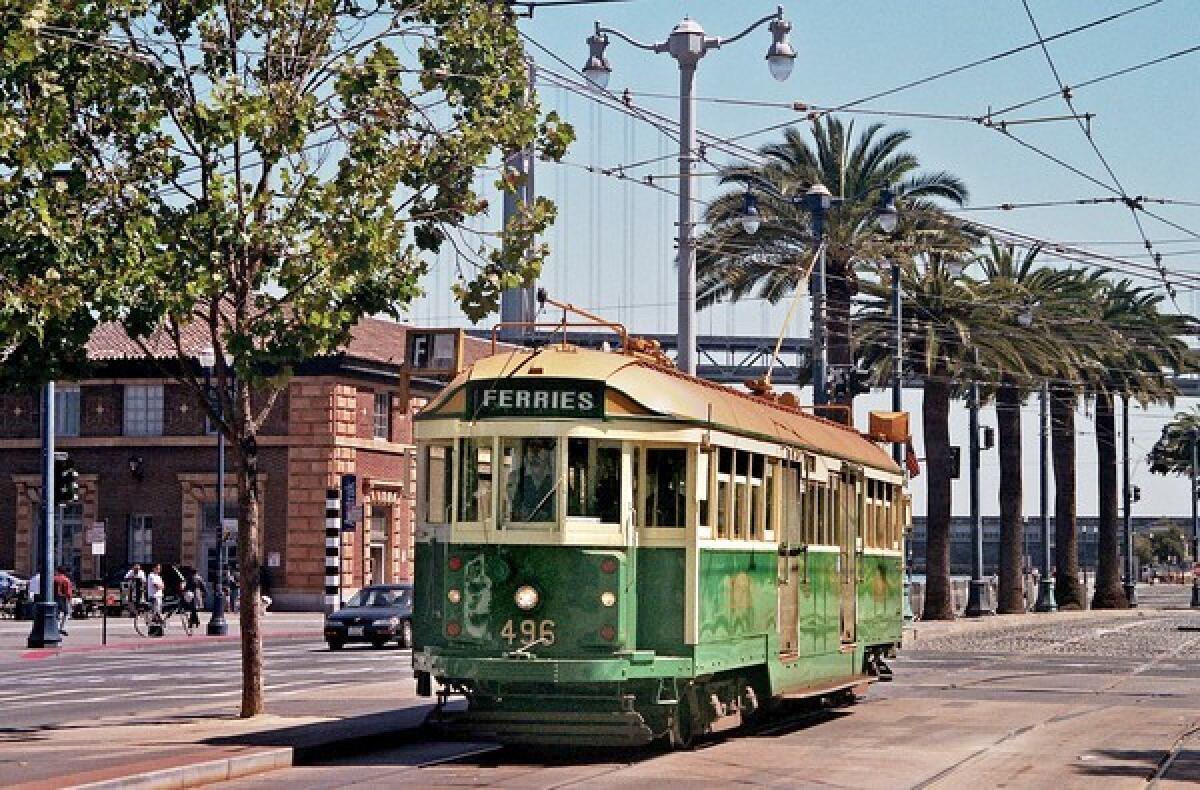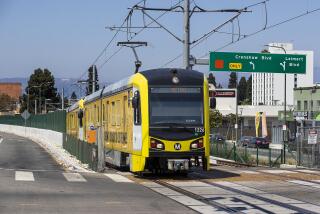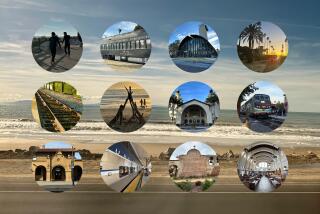San Francisco: The transit museum known as the F line

Reporting from San Francisco — The green-and-gold tram trundled down the road, a small Australian flag hanging out the driver’s window. I stared in amazement, momentarily forgetting my morning coffee. As it rumbled past, I could see the words “ Melbourne, Victoria, Australia” emblazoned on the side. But I was half a world away at an outdoor cafe in San Francisco.
I wasn’t the only one excited. “Look, Daddy, it’s a fashion train!” cried the little boy at the next table. I smiled; the term “fashion train” seemed apt. The other tram lines in San Francisco come in standard-issue silver and red. This line — the F — features historic streetcars from around the world in various shapes and colors. Each has its own look, stylishly reflecting the fashions of different eras and places.
Take the one painted a striking cobalt blue and canary yellow — the livery of San Francisco’s trams of the 1940s. Or the Washington, D.C., tram of the same era, with its interlocking curved stripes of white, pale blue, teal and red. My favorite is the San Diego car painted a postwar pea green with cream and brown trimmings and the instruction to “RIDE & RELAX” in black lettering on the side.
The F-line trams are not to be confused with the cable cars mentioned in every city guide. The popularity of the cable cars is easy to understand; both the machines themselves and the hills they climb are distinctively San Francisco and picturesque. But the cable cars are also crowded, and tickets cost $5, so they are more favored by tourists than locals.
That makes riding the less famous F-line trams more pleasant. They can be crowded near the waterfront, but through the Castro part of the service, you really can ride and relax. The varnished wood seats, lampshades with incandescent light bulbs and a satisfying screech and clatter add to the old-time atmosphere. On a foggy day, you may feel as though you’ve been transported back in time.
Yet this is no tourist trap. The F-line tram is a regular commuter service, and, unlike the cable cars, you don’t need a special ticket. Your $2 ticket transfer from any other part of the city’s transit system is valid if you want to ride. “Trainspotting” is, of course, free, if you don’t count the cost of brunch.
I always imagined a trainspotter as an English eccentric in an anorak, lurking about railways junctions and scribbling down train numbers in notebooks. I found this an inexplicable pastime until I discovered the joy of spotting different F trains as they glide about San Francisco. Now the simple act of catching public transport in this city has become a treasure hunt. There’s New Orleans! Melbourne, Australia! Los Angeles! With antique streetcars from dozens of cities around the world, it’s a transport museum on the streets.
After my encounter with the displaced Melbourne tram, I went to the San Francisco Railway Museum to find out more about the F fleet. The museum, a single room on Steuart Street at the Embarcadero, is not much bigger than a streetcar, but it is crammed with artifacts such as vintage fare boxes and traffic signals. The museum is free, but any money you spend in its gift shop helps fund restoration of the historic trams.
San Francisco is the Florida of the tram world; it’s where old streetcars go to retire. Just as San Francisco attracts people from around the world, so too it has streetcars from near and far. Milan, Italy, has the lead, contributing 10 cars to the fleet. The Milanese trams are characterized by wood-framed doors at the front, middle and back of the tram. There are two in yellow from the 1920s, two in green from the 1930s to 1970s, and six in the orange used since the 1970s. The fleet also includes a pre- World War II tram from Kobe and Hiroshima in Japan — green with a white roof and shaped like a bus. Meanwhile, a blue-and-white Swiss tram from the 1950s bears a coat of arms and the words “Zürich sister city of San Francisco.” I’ve even spotted a peculiar roofless tram from the seaside resort of Blackpool, England, which struck me as optimistic given the typical English weather.
There are now two trams from Melbourne on the streets of San Francisco. The one that first attracted my attention was the 1928 W2-class tram. The long wooden carriage, painted green with a pale gold roof, has closed sections at each end and two doorways in the middle. Its 1920s design is unaltered, aside from a fresh coat of paint and the wheelchair access and GPS navigation system.
There are also dozens of PCC trams, an American model designed by the Presidents’ Conference Committee in 1934 to try to lure passengers back to streetcars. They are a standard shape but painted in the colors of the cities that once operated them: Baltimore; Birmingham, Ala.; Boston; Brooklyn, N.Y.; Cincinnati; Dallas; Detroit; Kansas City, Mo.; Los Angeles; Minneapolis; New Orleans; San Diego; and Washington, D.C. I imagine brightly painted streetcars jiggling past the landmarks of America and wonder how different the U.S. would be if these cities still had this type of functioning public rail system.
The F line is the only streetcar line in San Francisco to run entirely above ground. It starts at Fisherman’s Wharf, with its vintage penny arcades and waxwork museums, runs along the Embarcadero, skirting the edge of the bay, and loops around the block at the Ferry Building, home to gourmet specialty shops and restaurants. The F then heads up Market Street, past the downtown area and into the Castro, the historic home of San Francisco’s gay scene. The end of the line is a block from the splendid Castro Theatre, a movie house dating from 1922, the same era as many of the trams.
My brunch spot was more than a mile away from the designated F route. I was at Toast, a cafe with outdoor seating on Church Street in the quiet family neighborhood of Noe Valley. This is J-line territory, so the vintage cars usually don’t come this way. But a driver explained to me that many trams use Church Street when entering or exiting service for the day because of the location of the depot, or “the barn.”
As the Melbourne tram disappeared down the hill, I turned back to my breakfast. But there was no return to business at the neighboring table, where the boy was equally distracted by the standard J-line trams. His father caught my eye, and we laughed. “Fashion train is a pretty clever name,” I told him. “Oh, that’s just because he can’t say ‘old-fashioned,’” he replied.
Maybe so, but they’ll always be fashion trains to me.
More to Read
Sign up for The Wild
We’ll help you find the best places to hike, bike and run, as well as the perfect silent spots for meditation and yoga.
You may occasionally receive promotional content from the Los Angeles Times.






